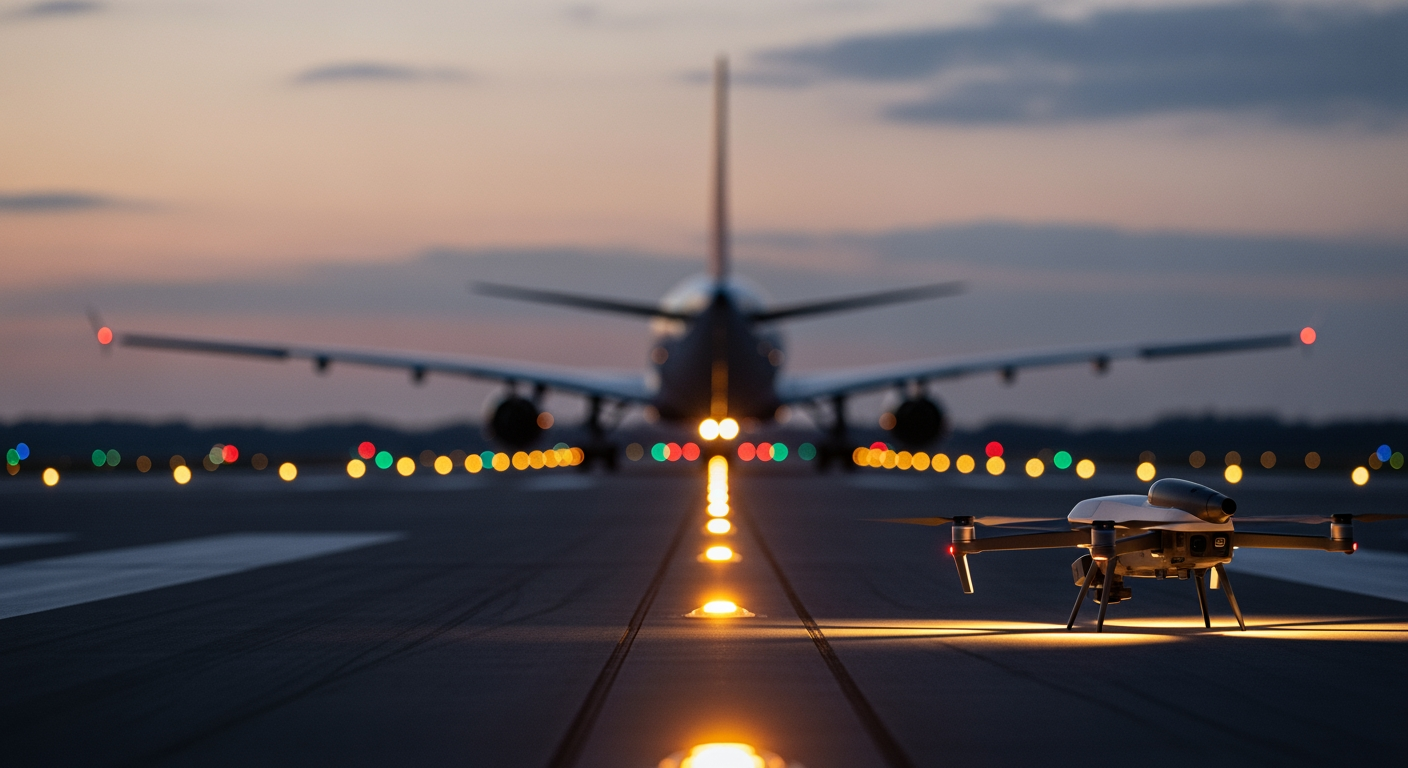Related Articles

APEC Leaders Chart Future Course with Landmark Declarations on AI and Demographics

Federal Judges Order Trump Administration to Fund Food Aid Amid Government Shutdown





BERLIN – Berlin Brandenburg Airport (BER) experienced a significant disruption to its operations late Friday, October 31, 2025, as flights were temporarily halted following multiple sightings of unidentified drones in the vicinity of the airfield. The two-hour suspension, which saw numerous flights diverted and delayed, underscores a growing and persistent challenge facing European aviation: the increasing frequency of unauthorized drone activity near critical infrastructure. This incident at the German capital's airport is the latest in a series of similar occurrences across the continent, prompting heightened security concerns and raising questions about the intentions behind such incursions.
The alarm was first raised around 8:00 PM local time on Friday when a witness reported a drone sighting near Berlin Brandenburg Airport. Shortly thereafter, a radio patrol car crew also observed a drone, confirming the unauthorized aerial presence. In response to the potential safety threat, airport authorities, in coordination with air traffic control, made the decision to suspend all take-offs and landings. This critical measure, implemented between approximately 8:08 PM (1908 GMT) and 9:58 PM, effectively grounded operations at one of Germany's busiest international gateways.
The immediate consequence was a cascade of operational delays and diversions. A "whole series of flights" originally bound for BER were rerouted to other German airports. Specific flights from cities including Stockholm, Antalya, and Helsinki were among those diverted, with one aircraft traveling from London redirected to Hamburg. Passengers faced considerable uncertainty, with announcements indicating that delays and cancellations were anticipated to continue well into the night. Over two dozen flights were ultimately affected by the disruption, highlighting the immediate and far-reaching impact even a brief airspace breach can have on air travel. The response involved the deployment of a police helicopter to search for the elusive aircraft, with the Federal Aviation Authority (LBA) also becoming involved in the investigation. Air traffic control’s standard procedure in such incidents includes restricting flight clearances to areas unaffected by drone presence, with a full halt of flights considered in severe cases until the situation is resolved through coordination among airport authorities and law enforcement.
The Berlin incident is not an isolated event but rather a stark reminder of a troubling trend that has intensified across Europe in 2025. Airports throughout the continent have experienced an unprecedented wave of disruptions caused by unauthorized drone incursions. Just weeks prior, in early October, Munich Airport was forced to suspend operations twice within 24 hours due to multiple drone sightings near its runways, impacting thousands of passengers and resulting in numerous flight cancellations. Similarly, in late September 2025, Denmark faced a significant wave of drone incursions, leading to multi-airport closures and diversions at Copenhagen, Aalborg, and Billund Airports. Norway's Oslo Airport also saw temporary airspace closures due to drone sightings. Countries like Belgium, France, and Spain have likewise grappled with similar challenges, forcing authorities to halt flights and heighten security.
Statistics underscore the growing magnitude of the problem. As of September 2025, Berlin's Brandenburg Airport had recorded six drone sightings this year. While this places BER in the middle range compared to other major German airports, with Frankfurt Airport reporting 37 sightings and Cologne/Bonn 13 in the first nine months of the year, the overall national picture is concerning. German Air Traffic Control (DFS) reported 172 incidents where drone activity impeded air traffic as of September 2025, already surpassing the total for the previous year. Many of these incidents, approximately 123, occurred within a 1.5-kilometer radius of airports, despite clear prohibitions against such activity. These figures demonstrate a persistent and increasing disregard for aviation safety regulations.
Germany, like many other nations, has established clear regulations to mitigate the risks posed by drones to aviation. Current German law prohibits drone flights within a 1.5-kilometer radius of airports without prior authorization from air traffic control and the LBA. Some regulations indicate a no-fly zone extending to 8 kilometers for non-EU residents. Violations of these no-fly zones can result in severe penalties, ranging from fines of €500 to over €50,000, and potentially lead to legal action or imprisonment, depending on the severity of the offense. Furthermore, any drone weighing over 250 grams must be registered with the Luftfahrt-Bundesamt (LBA), and third-party liability insurance is mandatory for all drone operations.
Despite these stringent regulations, enforcement remains a significant challenge. The unauthorized nature of these flights often means operators are difficult to identify and apprehend. The speed and maneuverability of drones, combined with the lack of precise tracking information for air traffic controllers, complicate efforts to mitigate threats once a drone is sighted. Although many incidents may be attributed to unaware hobbyist pilots, there is a growing concern that some incursions are deliberate and potentially malicious.
The increased frequency and apparent coordination of drone incidents across Europe in 2025 have prompted high-level security concerns among European officials. Danish officials, for instance, have described some incidents as a "hybrid attack," suggesting they may be part of a larger, coordinated campaign to test defenses or destabilize critical infrastructure. While direct attribution remains elusive, some officials have insinuated that Russia or state-backed actors could be responsible, though this remains unverified.
Beyond the immediate safety risks, there are broader implications for national security. Drones can be used for reconnaissance, gathering intelligence on airport layouts, security protocols, and flight patterns. There are also concerns about potential sabotage, whether through direct interference with aircraft or by serving as a distraction for other illicit activities. Adding another layer to this complex threat, reports have emerged of cyberattacks against security software used by several European airports, including Berlin Airport, coinciding with drone sightings. While a direct link has not been definitively established, the timing raises suspicions about potentially coordinated physical and digital incursions. The solidity of drones makes them a more dangerous threat than bird strikes, with tests demonstrating that even relatively small drones can cause significant structural damage to aircraft, including engines, particularly during critical phases of flight like takeoff and landing.
The drone incident at Berlin Brandenburg Airport serves as a stark reminder of the evolving security landscape surrounding critical transportation hubs. The temporary grounding of flights, the resulting passenger disruptions, and the need for immediate law enforcement and aviation authority response underscore the serious safety and operational challenges posed by unauthorized drone activity. As these incidents become more prevalent across Europe, the aviation industry, regulatory bodies, and security agencies face an urgent need to enhance detection capabilities, strengthen enforcement mechanisms, and explore advanced counter-drone technologies. The ongoing threat requires a multi-faceted approach, balancing robust security measures with continued public awareness campaigns to ensure the safety and integrity of European airspace.